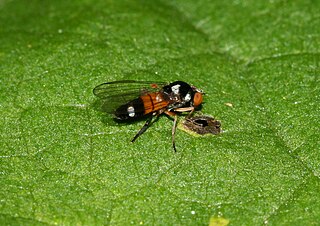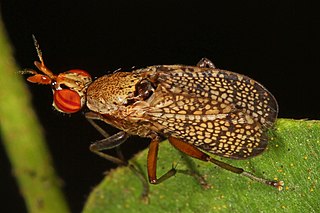
Psychodidae, also called drain flies, sink flies, filter flies, sewer flies, or sewer gnats, is a family of true flies. Some genera have short, hairy bodies and wings, giving them a "furry" moth-like appearance, hence one of their common names, moth flies. Members of the sub-family Phlebotominae, which are hematophagous, may be called sand flies in some countries, although this term is also used for other unrelated flies.

The Psychodinae are the nominate subfamily of moth flies (Psychodidae), also known as drain flies. Like most of their relatives, they are usually found in damp habitats; some occur in caves. The small larvae are aquatic or semi-terrestrial; the adults are winged and capable of flight. Psychodinae are found worldwide, including some subantarctic islands.

Callomyia is a genus of flies in the family Platypezidae. Some species can be found in Belgium.

Beridinae is a subfamily of soldier flies in the family Stratiomyidae.

Hybos femoratus is a species of fly in the family Hybotidae. It is found in the Palearctic.

Tetanocerini is a tribe of flies in the family Sciomyzidae. There are more than 400 described species in the tribe.

Acrocera is a genus of small-headed flies in the family Acroceridae.

Xylophagus is a genus of flies in the family Xylophagidae.

Ptychoptera is a genus of phantom crane flies in the family Ptychopteridae. There are at least 70 described species in Ptychoptera.
Dixella is a genus of meniscus midges in the family Dixidae. There are more than 70 described species in Dixella.
Maruina is a genus of moth flies in the family Psychodidae. There are at least 30 described species in Maruina. marui, diminutive for a fly.
Sycorax is a genus of moth flies and sand flies in the family Psychodidae. There are at least 40 described species in Sycorax.

Sciomyzinae is a subfamily of flies in the family Sciomyzidae.
Feuerborniella is a genus of flies belonging to the family Psychodidae.

Philosepedon is a genus of flies belonging to the family Psychodidae.
Peripsychoda is a genus of flies belonging to the family Psychodidae.
Paramormia is a genus of flies belonging to the family Psychodidae.
Panimerus is a genus of flies belonging to the family Psychodidae.











